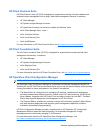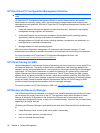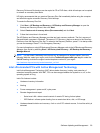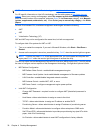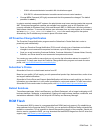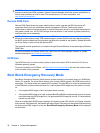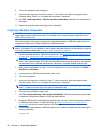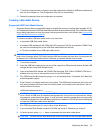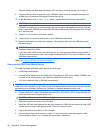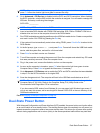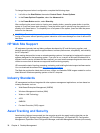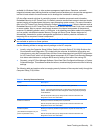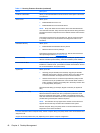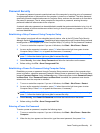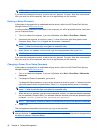
10. Turn off the computer to be configured. Insert the configuration diskette or USB flash media device
and turn the computer on. The configuration utility will run automatically.
11. Restart the computer when the configuration is complete.
Creating a Bootable Device
Supported USB Flash Media Device
Supported devices have a preinstalled image to simplify the process of making them bootable. All HP
or Compaq and most other USB flash media devices have this preinstalled image. If the USB flash media
device being used does not have this image, use the procedure later in this section (see
Unsupported
USB Flash Media Device on page 36).
To create a bootable USB flash media device, you must have:
●
a supported USB flash media device
●
a bootable DOS diskette with the FDISK and SYS programs (If SYS is not available, FORMAT may
be used, but all existing files on the USB flash media device will be lost.)
●
a PC that is bootable from a USB flash media device
CAUTION: Some older PCs may not be bootable from a USB flash media device. If the default boot
order in the Computer Setup (F10) Utility lists the USB device before the hard drive, the computer can
be booted from a USB flash media device. Otherwise, a bootable diskette must be used.
1. Turn off the computer.
2. Insert the USB flash media device into one of the computer's USB ports and remove all other USB
storage devices except USB diskette drives.
3. Insert a bootable DOS diskette with FDISK.COM and either SYS.COM or FORMAT.COM into a
diskette drive and turn on the computer to boot to the DOS diskette.
4. Run FDISK from the A:\ prompt by typing FDISK and pressing Enter. If prompted, click Yes (Y) to
enable large disk support.
5. Enter Choice [5] to display the drives in the system. The USB flash media device will be the drive
that closely matches the size of one of the drives listed. It will usually be the last drive in the list.
Note the letter of the drive.
USB flash media device drive: __________
CAUTION: If a drive does not match the USB flash media device, do not proceed. Data loss can
occur. Check all USB ports for additional storage devices. If any are found, remove them, reboot
the computer, and proceed from step 4. If none are found, either the system does not support the
USB flash media device or the USB flash media device is defective. DO NOT proceed in attempting
to make the USB flash media device bootable.
6. Exit FDISK by pressing the Esc key to return to the A:\ prompt.
7. If your bootable DOS diskette contains SYS.COM, go to step 8. Otherwise, go to step 9.
8. At the A:\ prompt, enter SYS x: where x represents the drive letter noted above.
CAUTION: Be sure that you have entered the correct drive letter for the USB flash media device.
Replicating the Setup 35



